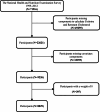The mediating role of inflammation in the association between cotinine levels and remnant cholesterol: a cross-sectional study
- PMID: 39567995
- PMCID: PMC11577861
- DOI: 10.1186/s12944-024-02372-x
The mediating role of inflammation in the association between cotinine levels and remnant cholesterol: a cross-sectional study
Abstract
Background: Remnant Cholesterol (RC) has emerged as a significant risk factor for cardiovascular disease. However, the factors influencing RC levels remain incompletely understood. This research investigates smoking-a major modifiable risk factor-to elucidate its impact on RC levels and examine the mediating role of inflammation in this relationship.
Methods: Using NHANES data from 1999 to 2018, this study analyzed the association between serum cotinine levels (a biomarker of smoking intensity) and RC in 8,829 participants aged 20 years and older. Through complex sampling design and adjustment for multiple covariables, we examined both linear and nonlinear relationships using linear regression models, restricted cubic splines (RCS), and subgroup analyses. Additionally, mediation analyses evaluated the role of inflammatory markers-neutrophils (NEU), monocytes (MON), lymphocytes (LYM), and platelets (PLT)-in this association.
Results: The high cotinine exposure group demonstrated significantly elevated RC levels (β = 2.256, 95% CI: 1.401-3.112, p < 0.001) compared to the no/minimal exposure group. This positive association was particularly pronounced in females (p for interaction < 0.05). Restricted cubic spline analysis demonstrated a nonlinear, N-shaped relationship (p for nonlinearity < 0.05), with RC levels reaching their peak at cotinine concentrations of approximately 172 ng/mL. In the mediation analysis, inflammatory markers showed significant mediating effects: NEU (28%), LYM (14.1%), PLT (9.5%), and MON (6.9%) of the total effect.
Conclusion: A significant positive association exists between cotinine and RC levels, moderated by sex. Inflammatory markers, particularly NEU, partially mediate this association.
Keywords: Biomarker; Cardiovascular disease; Cotinine; cross-sectional study; NHANES; Remnant cholesterol (RC).
© 2024. The Author(s).
Conflict of interest statement
Declarations. Ethics approval and consent to participate: This research complied with the Helsinki Declaration and used NHANES data which has undergone ethical review by NCHS. As a secondary analysis of this approved dataset following STROBE guidelines, no additional ethical approval was required. Consent for publication: Written informed consent for publication was obtained from all participants. Competing interests: The authors declare no competing interests.
Figures
Similar articles
-
Association between remnant cholesterol and arterial stiffness: Evidence from NHANES 1999-2018.Nutr Metab Cardiovasc Dis. 2025 Aug;35(8):104013. doi: 10.1016/j.numecd.2025.104013. Epub 2025 Mar 27. Nutr Metab Cardiovasc Dis. 2025. PMID: 40199709
-
Association of remnant cholesterol with insulin resistance and type 2 diabetes: mediation analyses from NHANES 1999-2020.Lipids Health Dis. 2024 Dec 18;23(1):404. doi: 10.1186/s12944-024-02393-6. Lipids Health Dis. 2024. PMID: 39695677 Free PMC article.
-
The relationship between remnant cholesterol and the risk of testosterone deficiency in US adults: a cross-sectional study based on the NHANES database.Front Endocrinol (Lausanne). 2024 Sep 24;15:1458193. doi: 10.3389/fendo.2024.1458193. eCollection 2024. Front Endocrinol (Lausanne). 2024. PMID: 39387048 Free PMC article.
-
Nonlinear association between visceral adipose tissue area and remnant cholesterol in US adults: a cross-sectional study.Lipids Health Dis. 2024 Jul 25;23(1):228. doi: 10.1186/s12944-024-02211-z. Lipids Health Dis. 2024. PMID: 39054500 Free PMC article.
-
Remnant cholesterol, preinflammatory state and chronic kidney disease: association and mediation analyses.Ren Fail. 2024 Dec;46(2):2361094. doi: 10.1080/0886022X.2024.2361094. Epub 2024 Jun 10. Ren Fail. 2024. PMID: 38856016 Free PMC article.
References
-
- Stürzebecher PE, Katzmann JL, Laufs U. What is “remnant cholesterol”? Eur Heart J. 2023;44:1446–8. 10.1093/eurheartj/ehac783. - PubMed
-
- Burnett JR, Hooper AJ, Hegele RA. Remnant cholesterol and atherosclerotic cardiovascular disease risk. J Am Coll Cardiol. 2020;76:2736–9. 10.1016/j.jacc.2020.10.029. - PubMed
-
- Castañer O, et al. Remnant cholesterol, not LDL cholesterol, is associated with incident cardiovascular disease. J Am Coll Cardiol. 2020;76:2712–24. 10.1016/j.jacc.2020.10.008. - PubMed
MeSH terms
Substances
LinkOut - more resources
Full Text Sources
Medical
Research Materials
Miscellaneous





